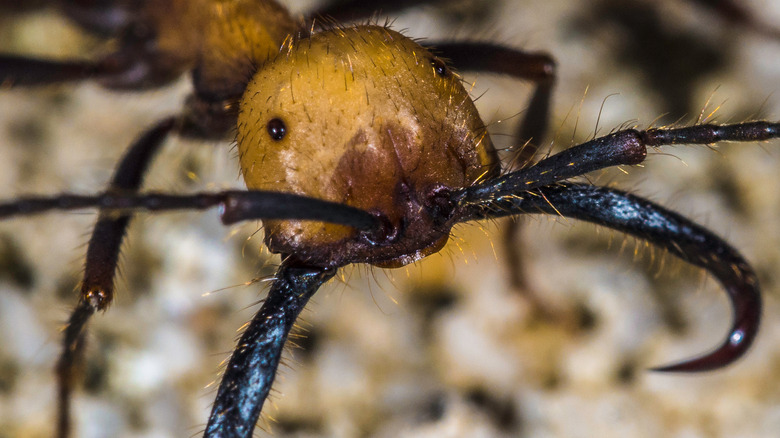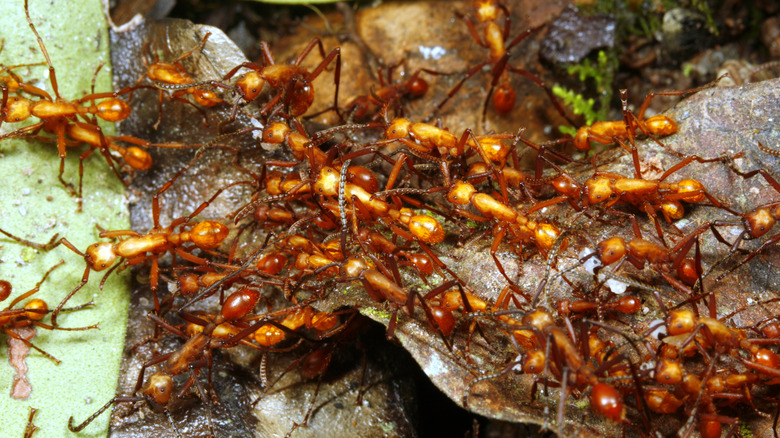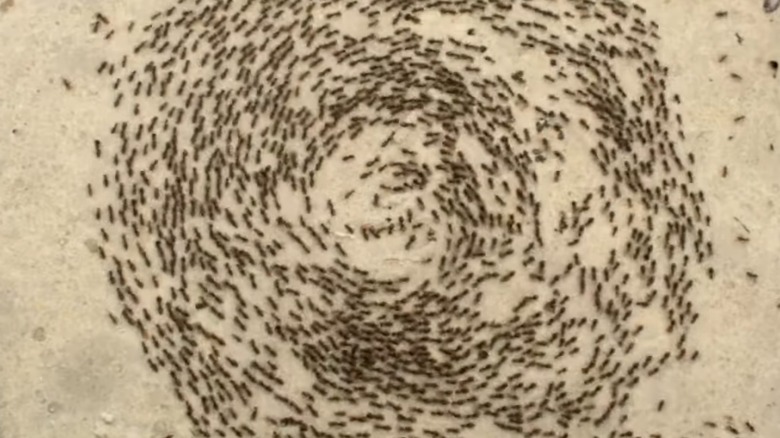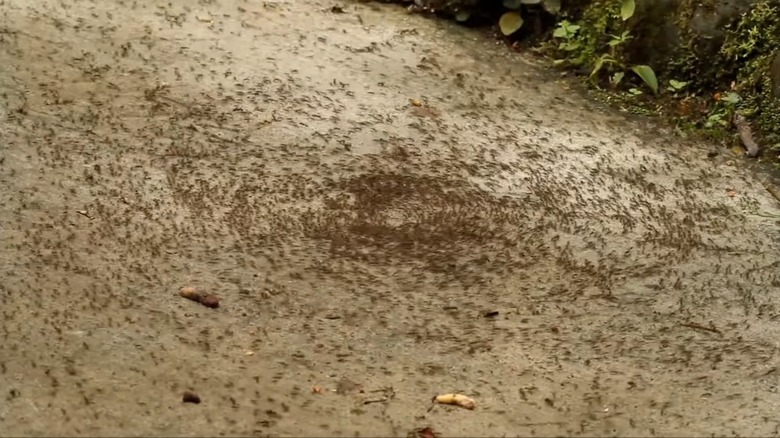The Truth Behind The Phenomenon Of The Ant Death Spiral
By most metrics, ants are an extremely successful animal. They're one of the most abundant creatures on Earth, with an estimated total population of 10 billion billion, per NPR. (Combined, the world's ants have a mass that's about 10 times greater than the total mass of all humans.) Plus, ants are ancient. As Reuters reports, one recently-discovered ant species is estimated to have evolved 120 million years ago — a time when dinosaurs still walked the Earth. While most creatures from that era have gone extinct, these ants continue to live.
Of course, ants are also extremely strong for their size. Per Arizona State University, ants can carry about 10 to 50 times their body weight. (That's like a human carrying an entire car over their head.) Ants also have a complex social structure that has fascinated scientists. Division of labor is built into ant biology, Reed College summarizes, with ants of various sizes and genders born to serve as soldiers, workers, drones, or the queen.
But these biological successes haven't stopped certain ants from partaking in some particularly silly behavior. Silly may be an understatement; "deadly" is more accurate. Certain ants — army ants in particular — are known to get themselves stuck in an endless, swarming, ultimately-fatal loop. The technical name for this phenomenon is an "ant mill" (not to be confused with "ant hill"). It's more commonly known as the "death spiral."
Army ants are 'practically blind' and rely on each other's pheromones to navigate
On paper, army ants are some of the most formidable ants around today. ("Army ant," by the way, is a term we use to refer to about 150 species of ant, per National Geographic.) According to Harvard University, army ants create "some of the largest insect societies on the planet." They also engage in massive, swarming "raids," where thousands (or even millions) sweep across the forest floor to hunt for food. Collectively, army ants are able to overpower creatures much larger than themselves and tear into them with their sharp mandibles.
But, as ScienceDirect writes, army ants are also "practically blind." In order to navigate, army ants rely on their heightened sense of smell, which they use to follow the pheromones of ants directly in front of them or other pheromone pathways that they've left behind on the forest floor. (Per The New York Times, ants detect pheromones via their antennae — they don't have noses — so "smell" may not be the perfect word.) This pheromone tracking is a useful ability, and it works for army ants a majority of the time. But not always.
Scent-reliant army ants end up in a fatal game of follow-the-leader
Imagine you're an army ant partaking in a raid. You follow the pheromone trail left by the ants in front of you. But something happens to weaken or obstruct that scent trail, and you veer off at an angle — perhaps down an older pheromone trail, under the false belief that it's the fresh one. (The ants behind you are following your lead. You better not let them down.) Then, all of a sudden, fresh pheromones ahead! Did you find your way back to the correct path? Unfortunately not. Unbeknownst to you, you're now following a chain of ants who are, in turn, following you.
As Gizmodo reports, this is exactly how an army ant death spiral begins; an ant loses the path, accidentally circles back, and leads all the ants behind it on an endless, looping march. Unless something disrupts the circle (or enough ants start to break away), spiraling army ants will continue marching until they die of exhaustion.
According to Time, this phenomenon was first identified by American entomologist W.M. Wheeler in 1910. "For nearly two whole days these blind creatures, so dependent on the contact-odor sense of their antennae, kept palpating their uniformly smooth, odoriferous trail and the advancing bodies of the ants immediately preceding them, without perceiving that they were making no progress but only wasting their energies," Wheeler wrote. "I have never seen a more astonishing exhibition of the limitations of instinct."
Death spirals can reach tremendous sizes
Army ant death spirals are creepy enough as is — but they can also reach terrifying sizes. Mental Floss reports that a scientist observed a death spiral in Guyana which reached 1,200 feet in circumference; it took each ant 2.5 hours to complete a single loop. This spiral lasted for two days, "with ever increasing numbers of dead bodies littering the route," until enough ants managed to break free from the chain.
If your heart is a bit warmer than that scientist's, you may want to free ants from their spiral. To do that, AntsAuthority suggests forming a new path using scented items you may have on hand. You'd think that, by now, army ants would've evolved a way to naturally escape their spirals. But, as NPR points out, a few thousand dead ants per year isn't so bad in a colony of many millions, so evolving an anti-death-spiral protocol hasn't been much of a priority for army ants.
Many have interpreted the ant death spiral as nature's metaphor — a parable with a message akin to "Don't always follow the crowd" or "Be wary of leaders who are just as blind as you." Thus, it should come as no surprise that this phenomenon has also inspired art. Perhaps the best example is the song "Spiral of Ants" by Lemon Demon (via YouTube), with the following chorus (posted on Genius): "Over and over / The pheromones, the overwhelming harmony / Consuming the colony / The Circle rules your life."



